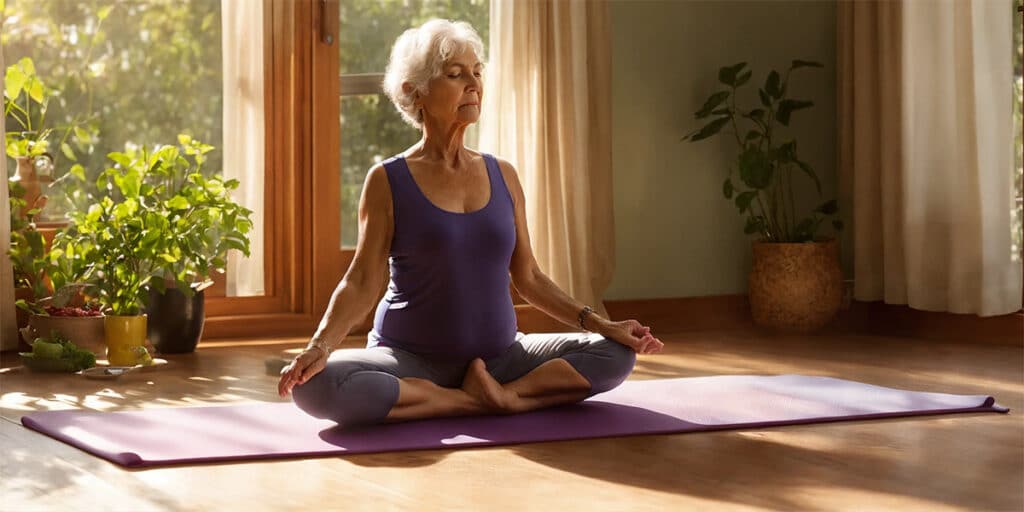In today’s fast-paced world, the prevalence of lifestyle-related diseases such as diabetes is on the rise, prompting individuals to seek holistic approaches to manage their health conditions. Among various wellness practices, Yin Yoga emerges as a potent tool for achieving deep relaxation and enhancing blood sugar stability.
This guide delves into the gentle yet profound practice of Yin Yoga, illustrating how its mindful approach can be particularly beneficial for those striving to maintain stable blood sugar levels.
The Essence of Yin Yoga
Yin Yoga, characterized by its slow-paced style, focuses on holding poses for extended periods, typically three to five minutes or longer. This practice targets the deep connective tissues, such as fascia, ligaments, and joints, promoting flexibility and energy flow. Beyond its physical benefits, Yin Yoga offers a meditative experience, encouraging practitioners to turn inward and explore the subtleties of their body and mind.
Unlocking the Benefits for Blood Sugar Control
- Stress Reduction: Chronic stress is a known factor that exacerbates blood sugar fluctuations. Yin Yoga’s meditative quality aids in stress reduction, thereby contributing to more stable glucose levels.
- Improved Insulin Sensitivity: The gentle stretches and deep relaxation techniques practiced in Yin Yoga can enhance insulin sensitivity, making it easier for the body to manage blood sugar.
- Enhanced Circulation: By promoting relaxation and reducing stress, Yin Yoga helps improve circulation, crucial for effective glucose metabolism and overall health.
- Weight Management: Regular practice of Yin Yoga, in conjunction with a balanced lifestyle, can aid in weight management, a key component in controlling diabetes.
Crafting Your Practice for Maximum Benefit
Crafting a Yin Yoga practice for maximum benefit, especially when aiming to stabilize blood sugar levels, involves a mindful and intentional approach that transcends the physical aspects of the practice. It’s about cultivating an environment and a mindset that foster deep relaxation and healing, both crucial for individuals managing diabetes.
The foundation of this practice lies in creating a serene and dedicated space for your sessions. This means selecting an area in your home or practice space that is away from the hustle and bustle of daily life, where distractions are minimized. The ambiance plays a significant role in facilitating relaxation; consider dim lighting, perhaps the use of candles or soft lamps, and maybe even some ambient, soothing music or nature sounds that can help in deepening your focus and relaxation.
When selecting poses, the emphasis should be on those that you can maintain comfortably for extended periods—typically anywhere from three to five minutes, or possibly longer. Yin Yoga’s effectiveness comes from its ability to apply gentle, sustained pressure to the connective tissues, which requires time. Choosing poses that suit your level of flexibility and comfort is crucial, as is being mindful of your body’s signals. Pushing too hard can lead to strain rather than the desired effect of relaxation and release.
Deep, mindful breathing is a cornerstone of Yin Yoga and its therapeutic benefits. Each breath should be seen as an opportunity to further relax and release tension. The breath acts as a bridge between the body and mind, helping not only to oxygenate the body but also to quiet the mind, reducing stress and, by extension, contributing to more stable blood sugar levels.
Props are invaluable allies in your Yin Yoga practice. Bolsters, blocks, and blankets aren’t merely tools for comfort; they are instruments of support that allow the body to ease into and maintain poses without strain. They make the practice accessible to all by accommodating different bodies and their unique needs. For example, a bolster under the knees in a forward fold can alleviate pressure on the lower back, while a blanket under the head or neck in a supine pose can enhance relaxation.
Incorporating these elements into your Yin Yoga practice not only maximizes the physical benefits, such as improved flexibility and enhanced insulin sensitivity, but also promotes mental and emotional well-being. This holistic approach to wellness is particularly beneficial for those managing diabetes, as it addresses not just the symptoms but the stressors and lifestyle factors that contribute to the condition. By approaching your practice with intention, creating a supportive environment, and listening to your body, you can unlock the profound benefits Yin Yoga has to offer for stable blood sugar and overall health.
| Yin Yoga Aspect | Benefit | Impact on Diabetes |
|---|---|---|
| Mindful Breathing | Enhances relaxation, reduces stress | May lower blood glucose levels indirectly through stress reduction |
| Gentle Stretching | Improves flexibility, targets connective tissues | Improves insulin sensitivity and circulation |
| Deep Relaxation | Decreases cortisol levels, enhances mental well-being | Supports stable blood sugar levels by mitigating stress-related spikes |
| Meditative Focus | Increases mindfulness and body awareness | Encourages healthy lifestyle choices beneficial for glucose control |
| Long Holds in Poses | Stimulates parasympathetic nervous system | Enhances overall metabolic function and well-being |
Embracing Deep Relaxation to Regulate Insulin and Manage Stress
Deep relaxation isn’t merely a state of rest; it’s a profound healing process for the body and mind, particularly beneficial for those striving to maintain stable blood sugar levels. Yin Yoga, with its emphasis on long-held, passive poses, offers a unique pathway to this deep state of relaxation, influencing the body’s physiological processes in ways that directly support diabetes management.
The Physiological Impact of Deep Relaxation
When the body enters a deeply relaxed state, it shifts from the sympathetic nervous system’s “fight or flight” response to the parasympathetic nervous system’s “rest and digest” mode. This transition is critical for individuals with diabetes for several reasons:
Enhanced Insulin Sensitivity: Deep relaxation has been shown to improve the body’s sensitivity to insulin, making it more efficient at lowering blood sugar levels. This improvement is crucial for managing diabetes effectively, reducing the risk of complications associated with the condition.
Stress Management: Chronic stress can lead to elevated cortisol levels, which in turn can increase blood glucose levels. Through the practice of Yin Yoga, individuals can significantly reduce stress, thus preventing stress-induced spikes in blood sugar. The deep relaxation achieved through Yin Yoga poses helps to balance cortisol levels, contributing to a more stable glycemic profile.
Integrating Deep Relaxation into Daily Life
Achieving a state of deep relaxation requires more than occasional practice; it needs integration into one’s daily routine. Here are some tips for making deep relaxation through Yin Yoga a regular part of diabetes management:
Consistency Is Key: Regular practice is essential. Carving out time each day for even just a few minutes of Yin Yoga can have a cumulative effect on stress levels and insulin sensitivity.
Mindfulness Matters: Incorporate mindfulness into your Yin Yoga practice. Being fully present in each pose allows for a deeper connection between mind and body, amplifying the relaxation benefits.
Personalize Your Practice: Tailor your Yin Yoga routine to address your specific needs and preferences. Focusing on poses that target areas of tension or stress in your body can enhance the effectiveness of your practice.
Seek Support: Consider joining a Yin Yoga class or finding a community of practitioners. Sharing the experience can provide additional motivation and insight, enriching your practice.
Yin Yoga for Stable Blood Sugar: Your FAQs Answered
What is Yin Yoga?
Yin Yoga is a gentle form of yoga that focuses on passive stretching, mainly targeting the body’s connective tissues. It emphasizes stillness and mindfulness, with poses held for longer periods.
How can Yin Yoga help manage blood sugar levels?
Through stress reduction, improved insulin sensitivity, and promotion of a calm, mindful state, Yin Yoga can indirectly support the stabilization of blood sugar levels.
Is Yin Yoga suitable for beginners?
Yes, Yin Yoga is suitable for practitioners of all levels, including beginners. Its gentle approach and use of props make it accessible to everyone.
How often should I practice Yin Yoga for it to be effective?
Regular practice is key. Starting with 2-3 times a week can offer noticeable benefits, including stress reduction and improved flexibility.
Can Yin Yoga replace my diabetes medication?
No, Yin Yoga should not replace any medical treatment for diabetes but serve as a complementary practice to support overall wellness.
Do I need any special equipment for Yin Yoga?
Basic yoga props like mats, bolsters, blocks, and blankets can enhance your practice, but you can start with just a mat.
What are some Yin Yoga poses good for diabetes?
Poses like Butterfly, Sphinx, and Dragon can be beneficial, focusing on relaxation and gentle stretching.
How long are the poses held in Yin Yoga?
Poses are typically held for 3-5 minutes, sometimes longer, to deeply work into the connective tissues.
Can Yin Yoga improve my sleep?
Yes, the relaxing nature of Yin Yoga can help improve sleep quality, which is beneficial for overall health and blood sugar regulation.
Where can I find Yin Yoga classes?
Many yoga studios offer Yin Yoga classes. Online platforms also provide a range of Yin Yoga sessions suitable for practicing at home.
Citations
- Hartley, L., Dyakova, M., Holmes, J., Clarke, A., Lee, M.S., Ernst, E., & Rees, K. (2014). “Yoga for the primary prevention of cardiovascular disease.” Cochrane Database of Systematic Reviews, (5), CD010072. This review explores the effects of yoga on cardiovascular health, which is closely linked to diabetes management.
- Cui, J., Yan, J.H., Yan, L.M., Pan, L., Le, J.J., & Guo, Y.Z. (2017). “Effects of yoga in adults with type 2 diabetes mellitus: A meta-analysis.” Journal of Diabetes Investigation, 8(2), 201–209. This meta-analysis consolidates the findings on yoga’s impact on adults with type 2 diabetes, highlighting significant benefits in blood glucose management and overall health.
- Innes, K.E., & Vincent, H.K. (2007). “The influence of yoga-based programs on risk profiles in adults with type 2 diabetes mellitus: A systematic review.” Evidence-Based Complementary and Alternative Medicine, 4(4), 469–486. This systematic review examines the effects of yoga interventions on risk factors among adults with type 2 diabetes, underscoring improvements in glycemic control, lipid profiles, and stress levels.
- Arora, S., & Bhattacharjee, J. (2008). “Modulation of immune responses in stress by Yoga.” International Journal of Yoga, 1(2), 45–55. While not directly related to diabetes, this study provides insights into how yoga can modulate immune responses, which is relevant for the overall health of individuals with diabetes.
- Kosuri, M., & Sridhar, G.R. (2009). “Yoga practice in diabetes improves physical and psychological outcomes.” Metabolic Syndrome and Related Disorders, 7(6), 515–517. This research article discusses the benefits of yoga practice in improving both physical and psychological outcomes for individuals with diabetes.





